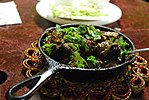

This article includes a list of references, related reading, or external links, but its sources remain unclear because it lacks inline citations. Please help improve this article by introducing more precise citations. (April 2011) (Learn how and when to remove this message)
|
| This article is part of the series on |
| Indian cuisine |
|---|
 |
|
Regional cuisines
|
|
Ingredients, types of food |
|
Preparation, cooking |
|
See also |
|
Related cuisines |
|
|
 |
| This article is part of the series |
| Pakistani cuisine پاکستانی پکوان |
|---|
|
Regional cuisines
|
|
Ingredients |
|
Preparation and cooking |
|
See also |
|
|
Parsi cuisine refers to the traditional cuisine of the Parsi people who had migrated into the Indian subcontinent from Persia, and currently spread across the modern-day South Asian republics of India and Pakistan.[1]
The basic feature of a Parsi lunch is rice, eaten with lentils or a curry. Curry is made with coconut and ras without, with curry usually being thicker than ras. Dinner would be a meat dish, often accompanied by potatoes or other vegetable curry. Kachumbar (a sharp onion-cucumber salad) accompanies most meals.
Popular Parsi dishes include:
Also popular among Parsis, but less so elsewhere, are the typical Parsi eeda (egg) dishes, which include akuri (scrambled eggs with spices) and the pora ("Parsi" omelette). Also, vegetables like okra, tomato, potato and others are often cooked with eggs on top.
Traditional breakfasts during the 1930s in Mumbai or in many South Gujarat villages consisted of khurchan (offal meats cooked with potatoes in a spicy gravy), and some variant of the ubiquitous deep-fried, fried or half-fried eggs. In agrarian communities, this would be washed down by copious quantities of coconut toddy, often straight off the tree.
Although in the not-so-distant past, vegetables were considered a 'poor peoples food', there is a presently a trend towards light eating, no red-meat and even vegetarianism.
Common desserts include sev (vermicelli), ravo (sweet semolina pudding) and malido (a nutty fudge). Also popular are faluda and kulfi, both of which are adoptions from the cuisines of the Irani and Persian-speaking communities. Wedding feasts traditionally include Lagan nu Custard.
Popular parsi snacks include bhakhra (deep fried sweet dough), batasa (tea biscuits), dar ni pori (sweetened lentils stuffed in a light pastry), doodh na puff (milk froth) and khaman na ladva (dumplings stuffed with sweetened coconut).